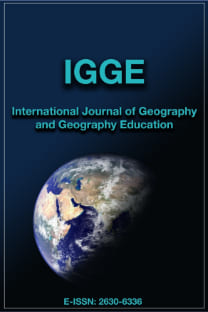COĞRAFYA EĞİTİMİNDE YÜKSELEN PARADİGMA: SÜRDÜRÜLEBİLİR BİR DÜNYA
Bilindiği gibi, 2005–2014 arasındaki süre Birleşmiş Milletler Sürdürülebilir Kalkınma için Eğitim Onyılı’dır. Şüphesiz ki eğitim, sürdürülebilirliği başarmada en önemli araçtır ve coğrafya eğitimi de gerekli bilgi, beceri, değer ve tutumları kazandırarak Birleşmiş Milletler Sürdürülebilir Kalkınma için Eğitim Onyılı’nın amaçlarına ulaşılmasında büyük bir katkı sağlayabilir. Buradan hareketle çalışmada, coğrafyanın sürdürülebilir kalkınma için eğitim konusunda önemli bir rol oynağı üzerinde durulmaktadır.
Anahtar Kelimeler:
Sürdürülebilirlik, Sürdürülebilir Kalkınma için Eğitim, Coğrafya Eğitimi
-
-
Keywords:
-,
___
- Alkis, S., Ozturk, M. (2007). “Sustainable Development in Opinions of Primary Student Teachers and Pre-Service Teacher Education in Turkey”, Geographiedidaktische Forschungen,Volume 42, Reinfried, Schleicher, Rempfler (Editors). IGU Geographical Views on Education for Sustainable Development, Proceedings of Lucerne-Symposium, Switzerland, 134-143.
- Boehn, D.L. (2007). “Intercultural Dialogue on Educational Approaches to Sustainability”. Geographiedidaktische Forschungen, Volume 42, Reinfried, Schleicher, Rempfler (Editors). IGU Geographical Views on Education for Sustainable Development, Proceedings of Lucerne-Symposium, Switzerland, 158-163.
- Calder, W., Clugston, R. (2005). Education for a Sustainable Future, Journal of Geography in Higher Education, Vol. 29, No. 1, 7–12.
- Catling, S. (2002). “Environmental Geography in English Primary Education”, in Hattingh, P. (ed.), Education for Sustainable Living, Proceedings of the Regional Symposium of the IGU Commission on Geographical Education.
- Demirci, A. (2006) “Developing international geography standards for a more sustainable future and its underlying reasons”, Proceedings of the Second International Conference of the Asian Philosophical Association, DaeDong Philosophical Association, pp. 413-426, Korea
- Haas, M. E. (1989). Teaching geography in the elementary school. ERIC.
- Haubrich, H. (2007). “Geography Education for Sustainable Development. Geographiedidaktische Forschungen”, Volume 42, Reinfried, Schleicher, Rempfler (Editors). IGU Geographical Views on Education for Sustainable Development, Proceedings of Lucerne-Symposium, Switzerland, 27-38.
- Houtsonen, L. (2002). Editorial: Geographical Education for Environmental and Cultural Diversity, International Research in Geographical and Environmental Education,Vol. 11, No. 3, 213-217.
- Houtsonen, L. (2004), Introduction: Geographical Education for Sustainable Living, GeoJournal, 60: 147–148.
- Unesco, (2007). http://www.unesco.org/education/tlsf/ erişim 31.10.2007 Unesco (2007). Highlights on DESD Progress to Date, http://portal.unesco.org/education/en/ev.php url_ıd=5117 2&url_do=do_topıc&url_sectıon=201.html Oxfam (2007), 11.10 2007 tarihinde erişilmiştir.
- http://www.oxfam.org.uk/education/resources/water_for_all/water/notes/ curric_eng.htm
- Kankaanrinta, I.K. ve Lavollee, D. (2007). “Geographical Information Systems in Education for Sustainable Development: A French Case in Environmental Issues”. Geographiedidaktische Forschungen,Volume 42, Reinfried, Schleicher, Rempfler (Editors). IGU Geographical Views on Education for Sustainable Development, Proceedings of Lucerne-Symposium, Switzerland, 103-108.
- Lucerne Declaration on Geographical Education for Sustainable Development, (2007). (Haubrich, Reinfried, Schleicher). Geographiedidaktische Forschungen,Volume 42, Reinfried, Schleicher, Rempfler (Editors). IGU Geographical Views on Education for Sustainable Development, Proceedings of Lucerne-Symposium, Switzerland, 243-250.
- McKeown, R., Hopkins, C., Rizzi, R., Chrystalbride, M. (2002). Education for Sustainable Development Toolkit, version 2. Knoxville: Waste Management Research and Education Institution.
- Pinchemel, P. (1982). The aims and values of geographical education. New Unesco Source Book for Geography Teaching, Ed. Norman J Graves. Essex: Longman/The Unesco Pres.
- Ray, W. (2007). “Placing Sustainable Development in the Curriculum of a Cultural Geography Course in the United States”. Geographiedidaktische Forschungen,Volume 42, Reinfried, Schleicher, Rempfler (Editors). IGU Geographical Views on Education for Sustainable Development, Proceedings of Lucerne-Symposium, Switzerland, 73-78.
- Sahin, S., Demiralp, N., Karabag, S. (2007). “Sustainable Development and Geography Curriculum of 2005 in Turkey: How Geography Student Teachers Conceptualizes Sustainable Development”. Geographiedidaktische Forschungen,Volume 42, Reinfried, Schleicher, Rempfler (Editors). IGU Geographical Views on Education for Sustainable Development, Proceedings of Lucerne-Symposium, Switzerland, 128-133.
- Summers, M., Corney, G. & Childs, A. (2004). Student teachers’ conceptions of sustainable development: the starting-points of geographers and scientists, Educational Research, Vol. 46, No. 2, 163-182.
- Summers, M., Kruger, C., Childs, A., Mant, J. (2000). Primary School Teachers’ Understanding of Environmental Issues: An Interview Study, Environmental Education Research, Vol. 6, No. 4, 293-312.
- The Earth Charter Initiative (2005). An Earth Charter Guidebook for teachers. http://www.earthcharter.org (accessed April 2007).
- Wade, R. (2002). Sustainable development education and curriculum 2000. Teaching Geography, Volume 27, Number 3, 108-111.
- Walford, R. (2001). Geography in British Schools 1850 - 2000: Making a World of Difference, London: Woburn Press.
- WCED (1987). World Commission on Environment and Development, Our Common Future. Oxford: OUP. http://www.undocuments.net/wced-ocf.htm erişim 31.10.2007
- Wiegand, P. (1993). Children and Primary Geography. London: Cassell
- Yayın Aralığı: Yılda 3 Sayı
- Başlangıç: 1996
- Yayıncı: Marmara Üniversitesi
Sayıdaki Diğer Makaleler
ÇANAKKALE BOĞAZI PETROL KİRLİLİK DÜZEYİNİN SAPTANMASI
Rüştü ILGAR, Kasim GÜVEN, Kasım Cemal GÜVEN
TRABZON HAVALİMANI’NA COĞRAFİ BİR YAKLAŞIM
AVRUPA BİRLİĞİ’NE UYUM SÜRECİNDE TÜRKİYE’DEKİ TARIMSAL İŞLETMELERİN GÜNÜMÜZDEKİ DURUMU
XVI. YÜZYILDA MANİSA ŞEHRİNİN NÜFUS ÖZELLİKLERİ
GEVAŞ KASABASI VE FONKSİYONLARI
Faruk ALAEDDİNOĞLU, Emin TOROĞLU, Mesut ELİBÜYÜK
COĞRAFYA EĞİTİMİNDE YÜKSELEN PARADİGMA: SÜRDÜRÜLEBİLİR BİR DÜNYA
